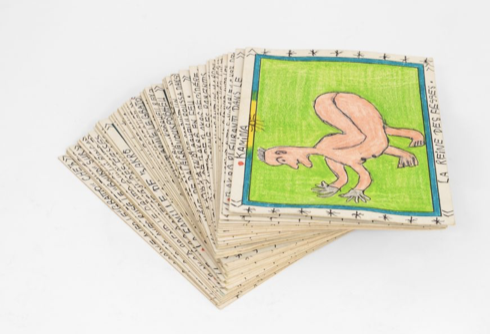Frédéric Bruly Bouabré

In Frédéric Bruly Bouabré’s work, representing the world around him is fundamental. “I observe, and what I see delights me. And so I want to imitate,” he declared.1 Over the course of his decades-long career, the Ivorian artist worked across many subjects and disciplines, researching and documenting various systems of knowledge.
Bouabré was committed to studying and memorializing his native Côte d'Ivoire’s Bété community, and he devoted his life to depicting as much information about it as he could. He first transcribed his oral Bété language in a notebook dated 1957. “Whoever knows these signs, could read my vernacular…. Should one wish to share them, may permission be granted, and help be provided, to teach them to humankind,” he wrote, hoping that his alphabet could contribute to universal kinship.2 Culminating in his largest series decades later, the Alphabet Bété comprises 449 ballpoint pen and colored pencil drawings, in which each postcard-size scene correlates to a monosyllabic Bété word.
Born in Zéprégühé, in western Côte d'Ivoire, Bouabré served in the French West African Navy and began his career as a government clerk in the colonial administration of French West Africa in Dakar, Senegal. Following his return to Abidjan, he worked as an informant and researcher to French ethnographers and anthropologists collecting and archiving information about his native peoples and other West African communities. In 1948 he experienced a prophetic revelation that prompted his exhaustive documentation of wide-ranging topics, which he first compiled in the form of writing, and subsequently through his art. “Thus, not knowing how to sing, not knowing how to dance, I preferred to write and make lots of drawings,” he explained.3
In the late 1970s, after decades of making handwritten manuscripts, Bouabré began to draw on found cardboard, combining image and text. From the 1980s onwards, as the scope of his interests grew, he embarked on an all-encompassing project, drawing from observation almost daily. He titled the open-ended series of drawings Connaissance du Monde, and worked on it until his death in 2014, systematically compiling and classifying forms, ideas, and a wide range of phenomena, including domestic objects, cloud formations, and tribal scarifications, as well as the political climate and world events. Synthesizing West African traditions and his global quest for knowledge, Bouabré envisioned his work as a vital form of didactic thought that reflected both personal and universal experiences.
Excerpt from MoMA
Read More
There are currently no artworks by this artist available on Latitudes. Please contact info@latitudes.online if you would like us to source works.





